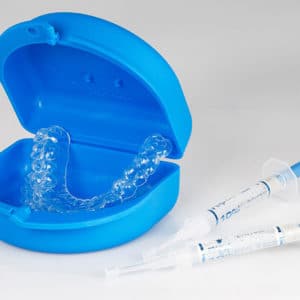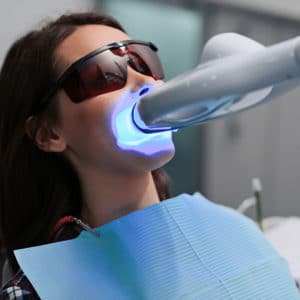
Having a row of whiter teeth can help to increase your confidence and overall appearance. Yellowish teeth, on the other hand, could have an adverse effect, often diminishing one’s self-esteem.
Persistent stains or a yellowish tinge on the teeth sometimes cannot be removed with simple dental scaling and polishing. Such deep stains require a more potent approach, which can be addressed and gently removed through professional teeth whitening procedures conducted by a trained dentist.
Teeth whitening services in Singapore are not just cosmetic enhancements; they are professional dental treatments. Beginning with a detailed consultation, your local dentist will evaluate the condition of your teeth to craft a personalised whitening strategy that aligns with your dental characteristics and aesthetic aspirations.
The heart of the treatment lies in the application of peroxide-based bleaching agents that delve beneath the enamel, targeting and oxidising the deep-seated stains that disrupt the natural whiteness of your teeth. Customised to each individual’s needs, the concentration of peroxide and the duration of its application may vary depending on the severity of discolouration and the desired outcomes.
It’s important to note that the most dramatic results are seen on teeth with a yellowish hue, as the procedure is specifically optimised for such cases. Brown or grey-toned stains might not respond as well. Additionally, teeth whitening does not affect the colour of dental restorations such as caps, veneers, dental implants and crowns, or fillings. Discolouration resulting from medications or trauma might also not be amenable to the whitening process.
Typically, the teeth whitening procedure will be completed within an hour. It commences with the application of a gum-protective gel, followed by the careful application of a hydrogen peroxide-based whitening agent by a trained dentist onto all visible surfaces of your teeth Depending on the selected procedure, an activating light might be employed for around 15 minutes to enhance the teeth whitening gel’s properties. Throughout this process, comfort and customisation are paramount, ensuring a pleasant experience leading to a brighter smile.
Home kit whitening is designed for ease and personalisation, offering a tailored solution to your teeth whitening needs. Afterwards, your dentist will provide you with a customised tray meticulously crafted to fit snugly over your teeth. Depending on the intensity of whitening desired, solutions of varying concentrations are applied within these trays, which can be worn either overnight or for specific intervals throughout the day, typically over a two-week period. This flexibility allows you to integrate the whitening process seamlessly into your daily routine with minimal disruption to your schedule.
The convenience of home kit whitening lies not only in its adaptability to personal timetables but also in its potential for a more controlled and gentle whitening journey. As the treatment unfolds, the custom-fit trays ensure consistent exposure of your teeth to the whitening agent, promoting even and effective lightening. While the process may be more gradual compared to in-chair procedures, it is particularly well-suited for those with mild to moderate discolouration, patiently edging towards the desired outcome. Nevertheless, the effectiveness of home kit whitening is dependent on individual dental characteristics and adherence to the prescribed regimen. A thorough consultation with a dental professional can help to increase the efficacy of this process, allowing for a well-informed and optimally beneficial teeth whitening experience.
Chairside whitening is a sophisticated in-clinic procedure that utilises advanced technology to achieve a brighter smile in a relatively short period. The procedure typically employs LED or laser technology to enhance the efficacy of the whitening gel applied to the teeth. This activation process, divided into three segments of approximately 20 minutes each, can accelerate the bleaching effect, which may enable significant shade improvement within just one visit.
To ensure patient safety and optimal results, the chairside whitening procedure will be executed by professional dentists. They are skilled in applying the precise concentration of whitening gel and adept at controlling the light source to prevent any potential damage to the tooth enamel or gum tissue. Moreover, dentists can provide immediate assistance and remedies in case of any sensitivity or discomfort, making chairside whitening a reliable and preferred choice for rapid and noticeable teeth whitening.
The teeth whitening process begins with a dental assessment to identify the underlying causes of tooth discolouration. This assessment helps the dentist determine the most appropriate treatment plan for each individual.
In-chair teeth whitening treatments typically involve a series of steps. Prior to the procedure, routine scaling and polishing may be performed to enhance the contact between the teeth and the bleaching agent. The dentist will then apply the whitening gel onto the teeth, which will be activated so that it can break down the stains and lighten the tooth colour. Depending on the initial condition of the teeth, a few sessions may be required to achieve the desired level of whitening.



For chairside whitening, LED or LASER is used to activate the whitening gel over three cycles of about 20 minutes per cycle in the dental office. This process has to be safely administered by professional dentists.
Teeth whitening treatment fees vary depending on the specific procedure chosen. The take-home teeth whitening kit starts from S$450 (excluding GST), while chairside whitening starts from S$888. It is essential to understand that these prices are approximate and may vary based on individual circumstances and the complexity of the case determined during the consultation with your dentist. Other dental services, such as dental scaling and polishing during routine checkups or porcelain veneers for more extensive stains or damaged teeth, are also available at different price points.
Intrinsic causes of teeth discolouration are related to factors that affect the internal structure of the teeth. One of the intrinsic factors is the natural ageing process, which can cause changes to the dentin, the inner tissue of the tooth, leading to a darker or yellowish appearance. This type of discolouration can also be exacerbated by prolonged exposure to acidic foods, which can erode the enamel and expose the darker dentin underneath.
Another intrinsic factor that can cause discolouration is the damage caused to a tooth’s outer layer due to aggressive brushing or tooth root infections. Aggressive brushing can wear away the enamel over time, and infections can cause discolouration from the inside out.
For a smooth teeth whitening experience and to minimise the risk of possible side effects, it is crucial to follow these guidelines:
After your teeth whitening treatment, it is essential to follow proper post-treatment care to maintain the results and promote oral health.
Teeth whitening is a popular cosmetic procedure in Singapore, but it is not without potential side effects and risks. Patients should be aware of these possible complications before undergoing teeth whitening treatments.
Teeth whitening is not recommended for children under the age of 16. This is because the pulp chamber, or nerve of the tooth, is enlarged during this age. Teeth whitening done on children under the age of 16 could cause their teeth to become sensitive.
Individuals with sensitive teeth and gums, receding gums and/or defective restorations should consult their dentist prior to using a tooth whitening system. Anyone allergic to peroxide (the whitening agent) should also not use a bleaching product.
It is advisable that teeth whitening is done only on patients with healthy teeth and gums. This means that there should not be any gum problems and that the teeth should be decay-free, or the patient may experience irritation to the gums and teeth. In addition, before any whitening is done, the teeth should be plaque/tartar-free so that the whitening gel can be in direct contact with the teeth. As such, dental scaling and polishing by a dentist needs to be done beforehand.
Teeth that exhibit uneven discolouration might present challenges to teeth whitening procedures, potentially leading to inconsistent or patchy results. Areas of the teeth that are discoloured differently may respond at varying degrees to the whitening process, which could accentuate the unevenness instead of correcting it. Additionally, it is important to recognise that teeth whitening treatments are ineffective on dental restorations such as crowns, veneers, and fillings. These materials dounding natural teeth become whiter, potentially leading to a mism not respond to bleaching agents as natural tooth enamel does, so they will remain unchanged while the surroatched appearance.
For more information on teeth whitening, refer to our guide on the six essential things to know about teeth whitening in Singapore.
At-home treatments usually involve using special bleaching trays fitted to your mouth and filled with a professional-grade hydrogen peroxide bleaching gel. With this method, you might be able to see more lasting results after six to nine months.
When getting teeth whitening done through a dental practitioner, you’ll have access to stronger concentrations of bleaching agents. The effects of a chairside teeth whitening session performed in various clinics across Singapore will typically last anywhere from six months up to four years but may depend on factors such as lifestyle choices (e.g. excessively drinking coffee) and oral hygiene habits (e.g. proper brushing).
If needed, touch-ups can always be done down the line, so don’t worry if there are slight signs of discolouration showing up again over time, these can be addressed via another exam with your dentist.
Since its inception in 2003, Family Dental Centre (FDC) has grown into a network of dental clinics in Singapore, driven by the mission to provide quality and accessible dental care to the community. As part of the Oracare Group and recognised by both the Singapore Medical Council and the Ministry of Health, our focus is on upholding high standards in dental services, a commitment that has led to our inclusion in Dental Asia and listing on HealthHub, Singapore’s leading health portal.
At FDC, understanding and meeting the individual needs of our patients is at the heart of what we do. Our expansion to 12 conveniently located clinics is a reflection of our commitment to making dental care accessible to all, supported by a team of 32 dental surgeons. Continuous professional development is key, ensuring our team is equipped to provide tailored, high-quality care. In recognition of Singapore’s diverse culture and languages, our staff are conversant in English, Mandarin, and Malay, facilitating clear and effective communication with our wide-ranging clientele.
Choosing Family Dental Centre means opting for a partner committed to your long-term dental health. Learn more about FDC and discover how we can be part of your dental care journey.
Contact
For more information, please contact our friendly customer service team
Menu
Services
Why Us